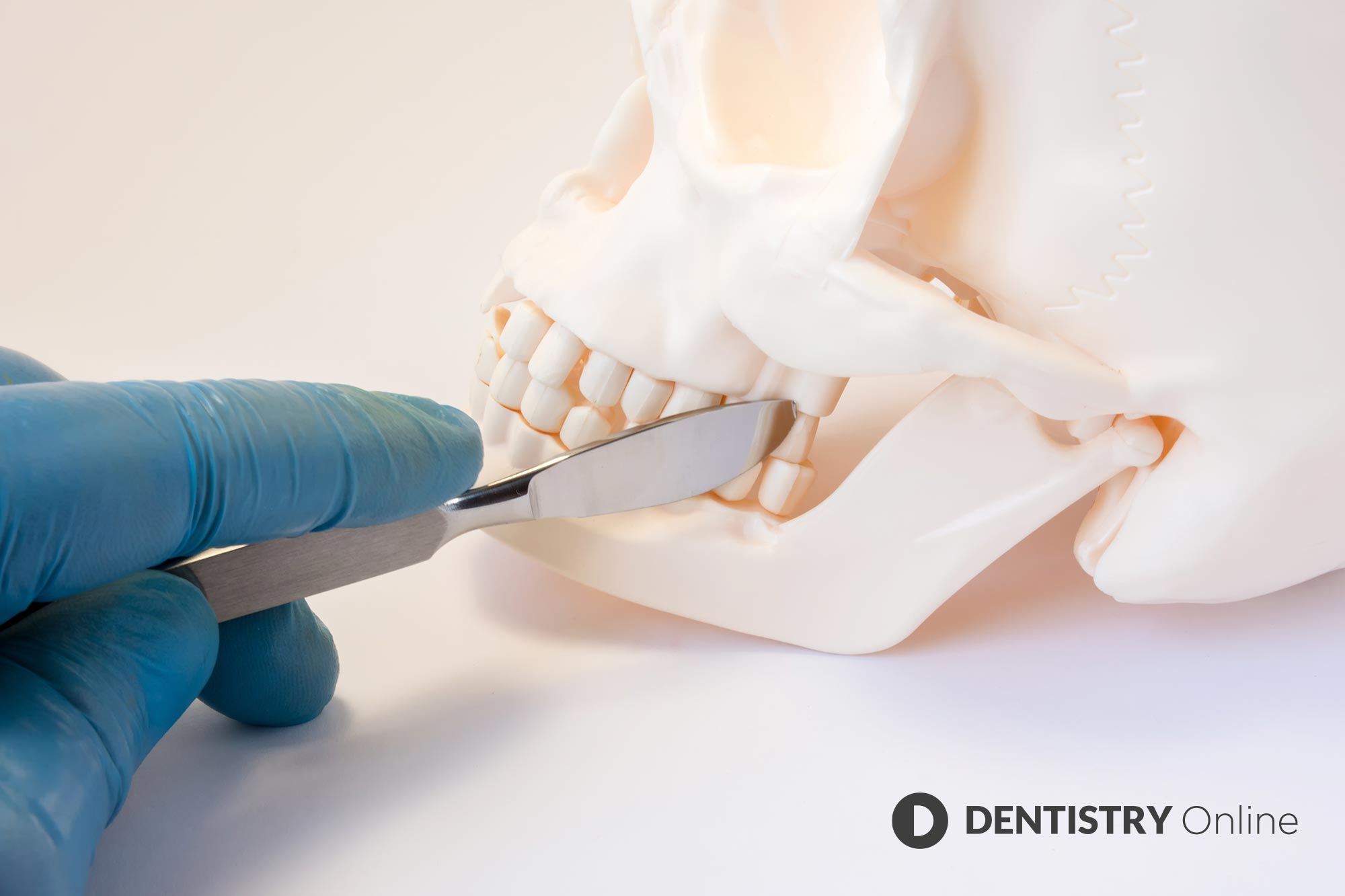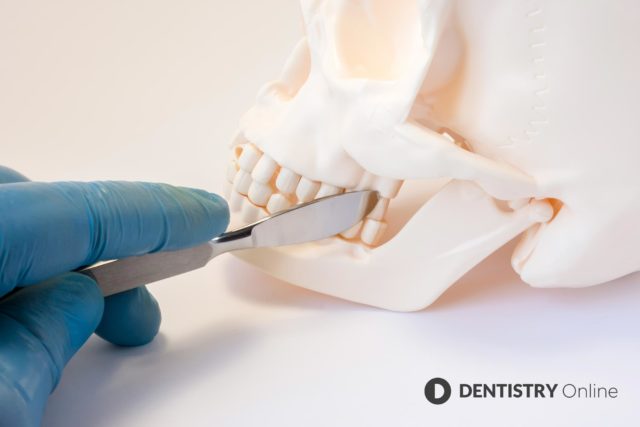 Implant Dentistry Today examines the latest papers published on bone regeneration and socket preservation.
Implant Dentistry Today examines the latest papers published on bone regeneration and socket preservation.
Socket preservation using eggshell derived nano hydroxyapatite with platelet-rich fibrin as a barrier membrane: a new technique
Kattimani VS, Lingamaneni KP, Kreedapathi GE, and Kattappagari KK (2019)
J Korean Association Oral Maxillofac Surg 45(6): 332-42
Objectives
Socket grafting is vital to prevent bone resorption after tooth extraction. Several techniques to prevent resorption have been described. Various bone graft substitutes have been developed and used with varying success. We conducted this pilot study to evaluate the performance of nanohydroxyapatite (nHA) derived from chicken eggshells in socket preservation.
Materials and methods
This was a prospective, single centre, outcome assessor-blinded evaluation of 23 sockets (11 patients) . It is grafted with nHA and covered with platelet-rich fibrin (PRF) membrane as a barrier. Bone width and radiographic bone density were measured using digital radiographs at one, 12, and also 24 weeks post-procedure. Postoperative histomorphometric and micro-computed tomography (CT) evaluation were performed.
The Institutional Ethics Committee approved the study protocol.
Results
All patients had uneventful wound healing without graft material displacement or leaching despite partial exposure of the grafted socket. Tissue re-epithelialised with thick gingival biotype (>3mm). Width of the bone was maintained and radiographic density increased significantly with a trabecular pattern (73.91% of sockets) within 12 weeks.
Histomorphometric analysis showed 56.52% grade three bone formation and micro-CT analysis revealed newly formed bone with interconnecting trabeculae.
Conclusion
Use of a PRF membrane with nHA resulted in good bone regeneration in sockets. Use of a PRF membrane prevents periosteal releasing incisions for primary closure, thereby facilitating the preservation of keratinised mucosa and gingival architecture.
This innovative, disease transfer risk-free technique uses egg-shell derived nHA and PRF membrane from the patient’s own blood. nHA is a promising economic bone graft substitute for bone regeneration and reconstruction because of the abundant availability of eggshell waste as a raw material.
Selected nanomaterials’ application enhanced with the use of stem cells in acceleration of alveolar bone regeneration during augmentation process
Zakrzewski W, Dobrzynski M, Rybak Z, Szymonowicz M, and Wiglusz RJ (2020)
Nanomaterials (Basel) 10(6): 1216
Abstract
Regenerative properties are different in every human tissue. Nowadays, with the increasing popularity of dental implants, bone regenerative procedures called augmentations become crucial in order to perform a successful dental procedure.
Tissue engineering allows for controlled growth of alveolar and periodontal tissues, with use of scaffolds, cells, and signalling molecules. By modulating the patient’s tissues, it can positively influence poor integration and healing, resulting in repeated implant surgeries.
Application of nanomaterials and stem cells in tissue regeneration is a newly developing field. There is great potential for maxillofacial bony defects. Nanostructured scaffolds provide a closer structural support with natural bone, while stem cells allow bony tissue regeneration in places when a certain volume of bone is crucial to perform a successful implantation.
Several types of selected nanomaterials and stem cells were discussed in this study. Their use has a high impact on the efficacy of the current and future procedures, which are still challenging for medicine. There are many factors that can influence the regenerative process, while its general complexity makes the whole process even harder to control.
The aim of this study was to evaluate the effectiveness and advantage of both stem cells and nanomaterials in order to better understand their function in regeneration of bone tissue in oral cavity.
Platelet-rich plasma for regeneration of neural feedback pathways around dental implants: a concise review and outlook on future possibilities
Huang Y, Bornstein MM, Lambrichts I, Yu HY, Politis C, and Jacobs R (2017)
Int J Oral Sci 9(1): 1-9
Abstract
Along with the development of new materials, advanced medical imaging and surgical techniques, some consider osseointegrated dental implants as successful and constantly evolving treatment modality for the replacement of missing teeth in patients with complete or partial edentulism.
The literature highlights the importance of restoring the peripheral neural feedback pathway. Thus repairing the lack of periodontal mechanoreceptors after tooth extraction.
Nevertheless, regenerating the nerve fibres and reconstructing the neural feedback pathways around osseointegrated implants remain a challenge. Recent studies have also provided evidence that platelet-rich plasma (PRP) therapy is a promising treatment for musculoskeletal injuries.
Because of its high biological safety, convenience and usability, PRP therapy has gradually gained popularity in the clinical field. Although much remains unlearned, the growth factors from PRP might play key roles in peripheral nerve repair mechanisms.
This review presents known growth factors contributing to the biological efficacy of PRP. It illustrates basic and (pre-)clinical evidence regarding the use of PRP and its relevant products in peripheral nerve regeneration.
In addition, the potential of local application of PRP for structural and functional recovery of injured peripheral nerves around dental implants is discussed.
Zheng C, Chen J, Liu S, and Jin Y (2019)
Stem cell-based bone and dental regeneration: a view of microenvironmental modulation
Int J Oral Sci 11(3): 23
Abstract
In modern medicine, bone and dental loss and defects are common and widespread morbidities. Regenerative therapy has shown great promise for such conditions. Mesenchymal stem cells, for example, obtained from various sources play an essential role in organ development and postnatal repair.
The Mesenchymal stem cells have exhibited enormous potential for regenerating bone and dental tissue.
Currently, mesenchymal stem cells (MSCs)-based bone and dental regeneration mainly includes two strategies: the rescue or mobilisation of endogenous MSCs and the application of exogenous MSCs in cytotherapy or tissue engineering.
Nevertheless, the efficacy of MSC-based regeneration is not always fulfilled, especially in diseased microenvironment.
Specifically, the diseased microenvironment not only impairs the regenerative potential of resident MSCs but also controls the therapeutic efficacy of exogenous MSCs, both as donors and recipients.
Accordingly, approaches targeting a diseased microenvironment have been established, including improving the diseased niche to restore endogenous MSCs, enhancing MSC resistance to a diseased microenvironment and renormalising the microenvironment to guarantee MSC-mediated therapies.
Moreover, the application of extracellular vesicles (EVs) as cell-free therapy has emerged as a promising therapeutic strategy.
This review summarises current knowledge regarding the tactics of MSCbased bone and dental regeneration and the decisive role of the microenvironment. It emphasises the therapeutic potential of microenvironment-targeting strategies in bone and dental regenerative medicine.
Guided bone regeneration: materials and biological mechanisms revisited
Elgali O, Omar O, Dahlin C, and Thomsen P (2017)
Eur J Oral Sci 125(5): 315-37
Abstract
Guided bone regeneration (GBR) is commonly used in combination with the instalment of titanium implants. The application of a membrane to exclude non-osteogenic tissues from interfering with bone regeneration is a key principle of GBR.
Membrane materials possess a number of properties which are amenable to modification. Additionally, a large number of membranes have been introduced for experimental and clinical verification.
Consequently, this prompts the need for an update on membrane properties and the biological outcomes. Critical assessments of the biological mechanisms governing bone regeneration in defects covered by membranes also got carried out.
The relevant literature for this narrative review was assessed after a Medline/Pubmed database search.
Experimental data suggest that different modifications of the physicochemical and mechanical properties of membranes may promote bone regeneration. Nevertheless, the precise role of membrane porosities for the barrier function of GBR membranes still awaits elucidation.
Novel experimental findings also suggest an active role of the membrane compartment per se in promoting the regenerative processes in the underlying defect during GBR, instead of being purely a passive barrier.
The optimisation of membrane materials by systematically addressing both the barrier and the bioactive properties is an important strategy in this field of research.
BMP-2 gene delivery-based bone regeneration in dentistry
Park SY, Kim KH, Kim S, Lee YM and Seol YJ (2019)
Pharmaceutics 11(8): 393
Abstract
Bone morphogenetic protein-2 (BMP-2) is a potent growth factor affecting bone formation. While recombinant human BMP-2 (rhBMP-2) has been commercially available in cases of non-union fracture and spinal fusion in orthopaedics, it has also been applied to improve bone regeneration in challenging cases requiring dental implant treatment.
However, complications related to an initially high dosage for maintaining an effective physiological concentration at the defect site have been reported, although an effective and safe rhBMP-2 dosage for bone regeneration has not yet been determined.
In contrast to protein delivery, BMP-2 gene transfer into the defect site induces BMP-2 synthesis in vivo and leads to secretion for weeks to months, depending on the vector, at a concentration of nanograms per millilitre. BMP-2 gene delivery is advantageous for bone wound healing process in terms of dosage and duration.
However, safety concerns related to viral vectors are one of the hurdles that need to be overcome for gene delivery to be used in clinical practice.
Recently, commercially available gene therapy has been introduced in orthopaedics, and clinical trials in dentistry have been ongoing.
This review examines the application of BMP-2 gene therapy for bone regeneration in the oral and maxillofacial regions and discusses future perspectives of BMP-2 gene therapy in dentistry.
Selection of collagen membranes for bone regeneration: a literature review
Sbricoli L, Guazzo R, Annunziata M, Gobbato L, Bressan E, and Nastri L (2020)
Materials (Basel) 13(3): 786
Abstract
Several treatment modalities have been proposed to regenerate bone. For example, guided bone regeneration (GBR) where barrier membranes play an important role by isolating soft tissue and allowing bone to grow. Not all membranes biologically behave the same way, as they differ from their origin and structure, with reflections on their mechanical properties and on their clinical performance.
Collagen membranes get widely used in medicine and dentistry. This is because of their high biocompatibility and capability of promoting wound healing.
Recently, collagen membranes have been applied in guided bone regeneration with comparable outcomes to non-resorbable membranes.
The aim of this work is to provide a review on the main features, application, outcomes. It also aims to review clinical employment of the different types of collagen membranes.
Comparisons with non-resorbable membranes are clarified, characteristics of cross-linked collagen versus native collagen, use of different grafting materials and need for membrane fixation are explored in order to gain awareness of the indications and limits and to be able to choose the right membrane required by the clinical condition.
Search criteria: These abstracts were curated from a search on Pubmed using the keywords dental implants, bone regeneration and socket preservation.
This article first appeared in Implant Dentistry Today magazine. You can read the latest issue here.
Let’s block ads! (Why?)






